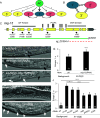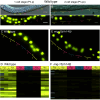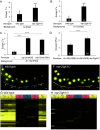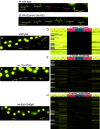RAP-2 and CNH-MAP4 Kinase MIG-15 confer resistance in bystander epithelium to cell-fate transformation by excess Ras or Notch activity
- PMID: 39739816
- PMCID: PMC11725784
- DOI: 10.1073/pnas.2414321121
RAP-2 and CNH-MAP4 Kinase MIG-15 confer resistance in bystander epithelium to cell-fate transformation by excess Ras or Notch activity
Abstract
Induction of cell fates by growth factors impacts many facets of developmental biology and disease. LIN-3/EGF induces the equipotent vulval precursor cells (VPCs) in Caenorhabditis elegans to assume the 3˚-3˚-2˚-1˚-2˚-3˚ pattern of cell fates. 1˚ and 2˚ cells become specialized epithelia and undergo stereotyped series of cell divisions to form the vulva. Conversely, 3˚ cells are relatively quiescent and nonspecialized; they divide once and fuse with the surrounding epithelium. 3˚ cells have thus been characterized as passive, uninduced, or ground state. Based on our previous studies, we hypothesized that a 3˚-promoting program would confer resistance to cell fate-transformation by inappropriately activated 1˚ and 2˚ fate-promoting LET-60/Ras and LIN-12/Notch, respectively. Deficient MIG-15/CNH-MAP4 Kinase meets the expectations of genetic interactions for a 3˚-promoting protein. Moreover, endogenous MIG-15 is required for expression of a fluorescent biomarker of 3˚ cell fate, is expressed in VPCs, and functions cell autonomously in VPCs. The Ras family small GTPase RAP-2, orthologs of which activate orthologs of MIG-15 in other systems, emulates these functions of MIG-15. However, gain of RAP-2 function has no effect on patterning, suggesting its activity is constitutive in VPCs. The 3˚ biomarker is expressed independently of the AC, raising questions about the cellular origin of 3˚-promoting activity. Activated LET-60/Ras and LIN-12/Notch repress expression of the 3˚ biomarker, suggesting that the 3˚-promoting program is both antagonized by as well as antagonizes 1˚- and 2˚- promoting programs. This study provides insight into developmental properties of cells historically considered to be nonresponding to growth factor signals.
Keywords: ACDS-10; LET-60; LIN-12; Rap2; citron NIK1 homology.
Conflict of interest statement
Competing interests statement:The authors declare no competing interest.
Figures





Similar articles
-
A rapid and systematic review of the clinical effectiveness and cost-effectiveness of paclitaxel, docetaxel, gemcitabine and vinorelbine in non-small-cell lung cancer.Health Technol Assess. 2001;5(32):1-195. doi: 10.3310/hta5320. Health Technol Assess. 2001. PMID: 12065068
-
Developmental fidelity is imposed by genetically separable RalGEF activities that mediate opposing signals.PLoS Genet. 2019 May 14;15(5):e1008056. doi: 10.1371/journal.pgen.1008056. eCollection 2019 May. PLoS Genet. 2019. PMID: 31086367 Free PMC article.
-
The Pax transcription factor EGL-38 links EGFR signaling to assembly of a cell type-specific apical extracellular matrix in the Caenorhabditis elegans vulva.Dev Biol. 2025 Jan;517:265-277. doi: 10.1016/j.ydbio.2024.10.008. Epub 2024 Nov 1. Dev Biol. 2025. PMID: 39489317
-
Integration of EGFR and LIN-12/Notch Signaling by LIN-1/Elk1, the Cdk8 Kinase Module, and SUR-2/Med23 in Vulval Precursor Cell Fate Patterning in Caenorhabditis elegans.Genetics. 2017 Dec;207(4):1473-1488. doi: 10.1534/genetics.117.300192. Epub 2017 Sep 27. Genetics. 2017. PMID: 28954762 Free PMC article.
-
Psychological interventions for adults who have sexually offended or are at risk of offending.Cochrane Database Syst Rev. 2012 Dec 12;12(12):CD007507. doi: 10.1002/14651858.CD007507.pub2. Cochrane Database Syst Rev. 2012. PMID: 23235646 Free PMC article.
References
MeSH terms
Substances
Grants and funding
LinkOut - more resources
Full Text Sources
Research Materials

